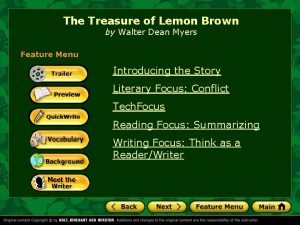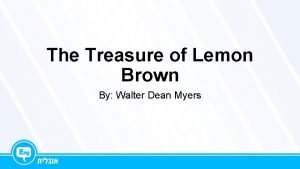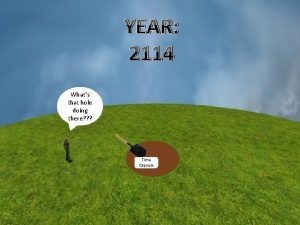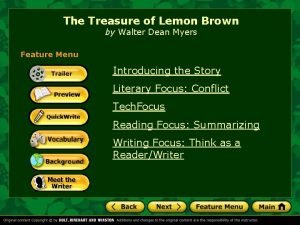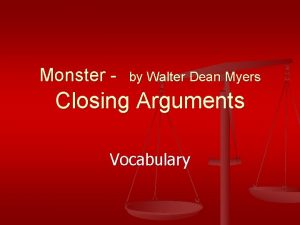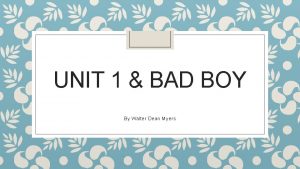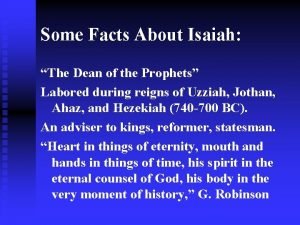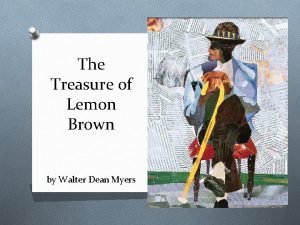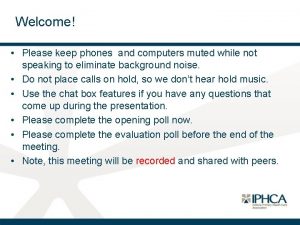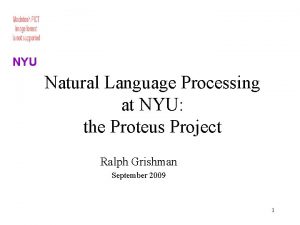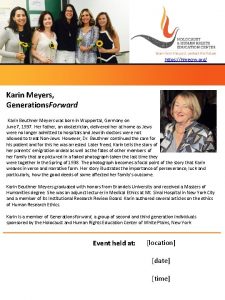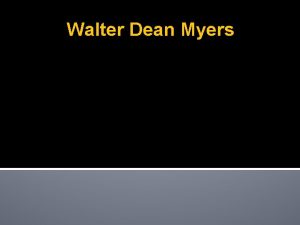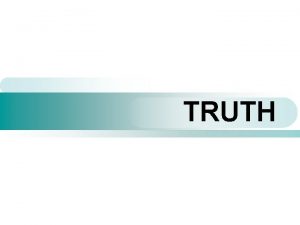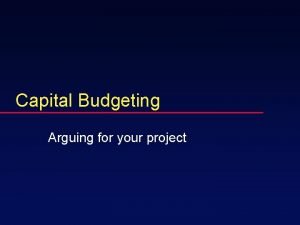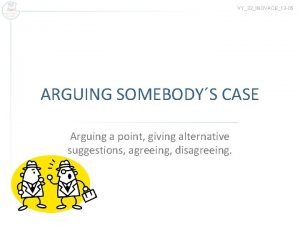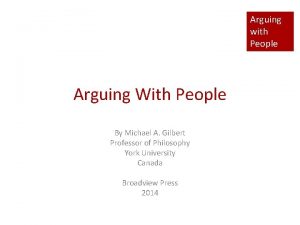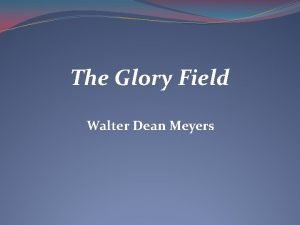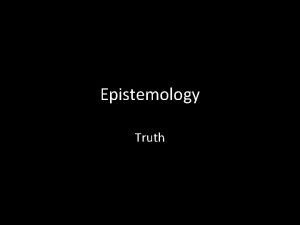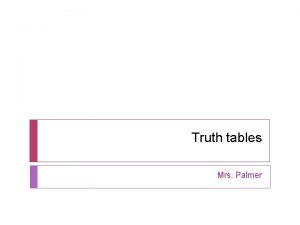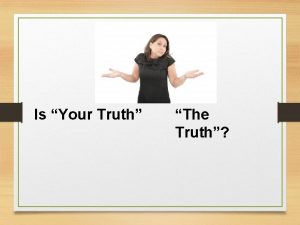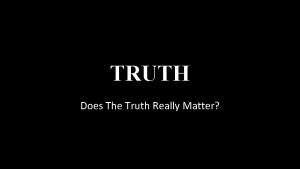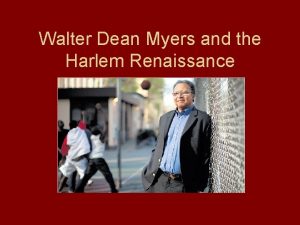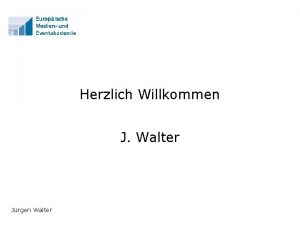ARGUING THE TRUTH Walter Dean Meyers Walter Dean


















- Slides: 18

ARGUING THE TRUTH

Walter Dean Meyers Walter Dean Myers is the critically acclaimed New York Times bestselling author of more than eighty books for children and young adults. He is considered one of the preeminent writers for children. Walter began writing at an early age. "I was a good student, but a speech impediment was causing problems. One of my teachers decided that I couldn't pronounce certain words at all. She thought that if I wrote something, I would use words I could pronounce. I began writing little poems. I began to write short stories, too. “ Walter Dean Myers died in New York City on July 1, 2014 after a brief illness.

Langston Hughes was born on February 1, 1902, in Joplin, Missouri. He published his first poem in 1921. He attended Columbia University, but left after one year to travel. His poetry was later promoted by Vachel Lindsay, and Hughes published his first book in 1926. He went on to write countless works of poetry, prose and plays, as well as a popular column for the Chicago Defender. He died on May 22, 1967.

Harlem by Langston Hughes, 1951 What happens to a dream deferred? Does it dry up like a raisin in the sun? Or fester like a sore-And then run? Does it stink like rotten meat? Or crust and sugar over-like a syrupy sweet? Maybe it just sags like a heavy load. Or does it explode?

Questions about the poem… 1. Define deferred, use a dictionary if needed. 2. What five things does Hughes compare a dream deferred to? 3. Why do you believe he used the items in #2 as comparisons? 4. What dream do you think he might be referring to? 5. Why do you believe he titled the poem “Harlem”? 6. What year was the poem written? Why is that significant? 7. Do you feel the poem is optimistic about the future? Why/why not?

SETTING—ANSWER THE FOLLOWING 2. The book starts out 1. What kind of 3. How does the setting feeling does the setting of the novel portray so far? A. Happy B. Sad C. Excited D. Lonely with this setting because the author wants to show: A. How Steve ended up in jail. B. How Steve feels about his trial C. How Steve is getting ready for the trial. D. How Steve has to live each day. affect Steve? A. He is more outgoing than other prisoners. B. He is more reserved/conservative than other prisoners. C. He thinks he does not belong there. D. He wants to forget he is in prison.

1. A. B. C. D. 2. WHAT TYPE OF 3. WHAT TYPE OF WHAT TYPE CONFLICT DOES OF CONFLICT RICHARD “BOBO” STEVE FACE? DOES THE JURY EVANS FACE? A. PERSON VS. PERSON B. PERSON VS. SOCIETY C. PERSON VS. NATURE D. PERSON VS. SELF 4. WHAT TYPE OF CONFLICT DO THE TWO CONSPIRATORS FACE? A. PERSON VS. PERSON B. PERSON VS. SOCIETY C. PERSON VS. NATURE D. PERSON VS. SELF

12 Angry Men 12 jurors are gathered to decide the fate of the accused. They are in a hurry to get home, so they decide that they should all just vote “guilty”, but one juror refuses, saying that he feels the man deserves a fair trial. They discuss the evidence and revote several times. Eventually, they all vote “not guilty” except one last juror www. youtube. com/watch? v=dzh. H 2 hl. NSfs

FLASHBACKS An interruption of the chronological sequence (as of a film or literary work) of an event of earlier occurrence. Flashbacks are often used for comedic effect, to prove or contradict something in the present. For example, if a character in a sitcom claims he does the dishes every single night, flashbacks could show him ignoring a giant pile of dirty dishes on various occasions. Flashback can also mean a sudden, vivid remembrance of past events, like having a flashback to your kindergarten days if you go visit that classroom today.

IDIOMS A phrase that is understood as to mean something quite different from what individual words of the phrase would imply. For example: At the drop of a hat Barking up the wrong tree It’s a piece of cake Don’t bite off more than you can chew IDIOMS

Journal Entry 1 On page 76, it says, “You act like garbage, they treat you like garbage”. Is this really the way it works? If people act like garbage, do they deserve to be treated like garbage?

IRONY The expression of one's meaning by using language that normally signifies the opposite, typically for humorous or emphatic effect. Irony is a figure of speech in which words are used in such a way that their intended meaning is different from the actual meaning of the words. It may also be a situation that may end up in quite a different way than what is generally anticipated. In simple words, it is a difference between the appearance and the reality. On the grounds of the above definition, we distinguish two basic kinds of irony i. e. verbal irony and situational (ALSO CALLED DRAMATIC) irony. A verbal irony involves what one does not mean. When in response to a foolish idea, we say, “what a great idea!” it is a verbal irony. A situational irony occurs when, for instance, a man is chuckling at the misfortune of the other even when the same misfortune, in complete unawareness, is befalling him.

EXAMPLES OF IRONY I posted a video on You. Tube about how boring and useless You. Tube is. The name of Britain’s biggest dog was “Tiny”. You laugh at a person who slipped stepping on a banana peel and the next thing you know, you slipped too. It was a tragic irony that he made himself sick by worrying so much about his health. IRONIC. . . MAYBE?

Journal Entry 2 Use specific evidence from the text (a quote) to prove that the guards think Steve is guilty.

Journal Entry 3 If you had to vote right now, would you say Steve is innocent or guilty? What has Steve done wrong throughout this experience/ What has he done right?

CHARACTERIZATION 1. WHO IS THE PROTAGONIST OF OUR STORY? 2. WHO IS THE ANTAGONIST? 3. DISCUSS HOW STEVE IS, OR IS NOT, A ROUND CHARACTER. 4. DISCUSS HOW STEVE IS, OR IS NOT, A DYNAMIC CHARACTER. 5. ARE THERE ANY EXAMPLES OF FLAT CHARACTERS IN THIS STORY? 6. ARE THERE ANY EXAMPLES OF STATIC CHARACTERS IN THIS STORY?

BODY BIOGRAPHY For this lesson you will be creating a written and visual portrait of our story’s protagonist. Take notes on the following before you create your project. • Heart—Special Relationships – Who/What is closest to this character? Place this character in the heart. • Spine—Important goal – What is this character trying to accomplish throughout the story? What drives his/her thoughts and actions? • Strengths & Weaknesses—What is something that you admire about your character? What is a personal quality that needs to be improved? How can that character improve this weakness? Symbols—What objects could be used to symbolize, or represent, the character? Why did you choose these objects? These will be placed in your drawing. Hands: What does this person hold in their hands – literal and figurative?

Continued… Changes—Use thought balloons to show the character changed throughout the story. The Background: what elements make up this person’s environment/background Mirror, Mirror—How does the character see himself? Display this inside a mirror. How is this different from the way others see the character? Display this outside of the mirror. Quote—Think of appropriate quotes that best describe the character and their growth throughout the story. Use at least three Now you will create a poster for your character. All of the elements included in your analysis must be included on your poster. You will be graded on completion and CREATVITY! Use your imagination and your brain power to bring the character to life! Draw an outline on your group’s paper and begin.
 Dean d dean
Dean d dean Conflict in the treasure of lemon brown
Conflict in the treasure of lemon brown Monster walter dean myers vocabulary
Monster walter dean myers vocabulary The treasure of lemon brown story
The treasure of lemon brown story Newberry honor book
Newberry honor book The treasure of lemon brown activities
The treasure of lemon brown activities Monster walter dean myers vocabulary
Monster walter dean myers vocabulary Bad boy by walter dean myers
Bad boy by walter dean myers Bad boy walter dean myers summary
Bad boy walter dean myers summary Facts about isaiah the prophet
Facts about isaiah the prophet Mr irwin lasher
Mr irwin lasher Christopher jayne
Christopher jayne Irwin lasher
Irwin lasher The treasure of lemon brown, greg character traits
The treasure of lemon brown, greg character traits Pia meyers md
Pia meyers md Adam meyers nyu
Adam meyers nyu Shawna meyers
Shawna meyers Karin meyers
Karin meyers Dr meyers dorsten
Dr meyers dorsten

